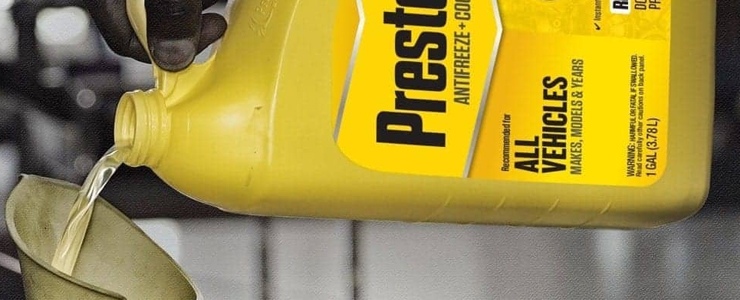
Preparing Your Car For Winter: 10 Useful Tips
As the first autumn leaves are finding their way to the ground below, we’re preparing for fewer daylight hours, stronger winds and lower temperatures. Although winter may still seem far away, chances are the first snowflake will drop sooner than we might expect. And while you can easily take out your winter coats, the scarves and gloves, there’s a bit more preparation to do when it comes to winterizing your vehicle.
Here are 10 useful tips to get your car ready for the cold season, to ensure it will run smoothly and not let you down.
1. Replace oil and dirty filters

As much as you hate a clogged nose during wintertime, your car has it worse when it comes to clogged filter. Just as you’re using your nose to draw air from the environment and your kidneys to filter out wastes and extra fluid, your car makes use of its mechanical filters to keep the engine running clean and smooth.
Replacing your filters will ensure the engine receives better quality air, fuel and oil for the upcoming cold season. In addition to the oil filter, it’s advisable to replace motor oil as well. For older vehicles, you may even opt for a lower cold viscosity oil, allowing the engine to face less friction resistance when cold starting, improving the life of your battery.
What does oil viscosity have to do with battery life, you may ask? When turning the ignition key or pressing the start button, the engine starter draws power from the battery to spin the crankshaft and allow the engine to rev. If there is less resistance in the cylinders and crankshaft journals, less power is required by the starter and thus less stress is applied to the battery.
2. Cooling system maintenance

This one might sound counter intuitive. Why would you care so much about the cooling system when it’s already cold outside? Well, even when temperatures drop below the freezing point, it’s important to have a properly functioning cooling system. The main danger appears when your car has been sitting in the garage overnight and needs to start up in the morning.
When winter approaches, it is necessary to drain coolant from your radiator and cooling tubes and replace it with some that has a lower freezing point. There are winter-specific coolants available in car shops; just make sure to choose one that is compatible with your engine.
If coolant freezes in your car’s cooling system, there is a good chance that the coolant pump won’t be able to spin and move fluid around when starting your vehicle. Therefore, its pellets will break, and metal pieces could advance through the cooling system, causing extensive damage to the hoses and the radiator.
In conclusion, when winter arrives, replace your summer coolant with an adequate antifreeze winter coolant and check for any leaks around the cooling system.
3. Heater and defroster checks

If there’s one thing you absolutely want to have during winter, it’s the heating system. There’s nothing as good as getting into your car after it sits in subzero wind-chill and enjoying the heat coming from your car’s air vents.
However, in order to ensure you’ll be warm and toasty inside your car when it matters most, you must ensure your car’s heater works properly before winter sets in.
There are two types of heating systems in any vehicle: engine coolant and electrical. Older cars often use heated coolant coming out of the engine to redirect heat towards the cabin. The coolant takes a secondary route before reaching the car’s radiator and passes through a smaller heat exchanger near the dashboard. Heat is then blown from the heat exchanger through air ducts in the dashboard and on through the car’s air vents.
General heater maintenance requires checking the secondary coolant route as well as the heat exchanger for any leaks or plugs. If coolant has a continuous, leak-free environment and fans are working properly, your car is good to go.
Modern cars come equipped with an auxiliary heating system that uses electricity passing through a heating element to warm the driver or passengers. Heated seats and steering wheels are also common with electric vehicles, where it’s more energy efficient to heat them rather than the whole cabin.
You should check that seats heat properly and that there are no warning lights on the dashboard regarding their functionality. If there is any malfunction with your car’s heated seats, it is highly recommended to ask for professional help in diagnosing and repairing the issue before winter sets in.
4. Inspect lights and bulbs

Probably one of the most annoying things about wintertime is that we get less and less daylight. There’s a good chance you will be leaving to and from work when it’s already dark, not getting the chance to enjoy a bit of sunshine. And if you do manage to leave work early, you might be welcomed with a big dose of fog on the road.
It’s critical for your safety and the safety of other road participants that your car’s lights are fully functional. Do a general check on your vehicle’s lighting system. Check if low and high beams are functional on both headlights, check signals, taillights and fog lights. If your headlights’ glass is hazy it may be a good idea to buy a headlight restoration kit or ask for a professional to have a go at it with their polisher. You may be surprised how much illumination can be lost due to this common issue.
Being visible is especially important in low-light, foggy and stormy weather conditions. Don’t let faulty lights take you by surprise this winter.
5. Check your battery

The battery is the source of all your car’s main functions. Electricity is needed everywhere, from starting the engine to operating turn signals, listening to the radio, working your windshield wipers or lowering the windows.
During cold winter mornings, your car’s starter motor will draw vast amounts of power from the battery in order to get the engine running. If you’re running a diesel engine, then even more power is required by the incandescent plugs to heat up and ignite the fuel mixture in the combustion chamber.
A healthy battery is going to prevent a lot of problems during winter. Have your car’s battery checked at a professional service center. If the battery is rather old, chances are it cannot keep a good amount of charge, especially over a cold winter night, rendering your car unusable in the morning.
If you need to replace your old car battery, choose one with a high number of cold-cranking amps (CCA), as it will perform better during cold engine starts.
6. Replace worn tires

Tires form the only 4 contact patches between your car and the road. Every bit of power is transferred from the engine to the ground via your car’s tires. And, when winter’s slippery conditions hit, you want to make sure you’ve got adequate tires to overcome the challenge.
Tires don’t last forever. As miles add on, tread wears off and gets to the point where a replacement is needed. All-season tires may be used during both summer and winter. However, if you happen to be running summer tires, you’ll want to switch to winter tires before the cold season comes unless you want to end up in the ditch come snow and ice. Winter tires feature a softer compound and specially designed thread patterns to attain higher grip and evacuate snow, icy slush and water faster.
Going for a premium, more expensive tire instead of a cheap, budget tire will pay off in terms of longevity, handling and performance in low grip conditions. Name brand ‘premium tires’ can reduce braking distances on snow and ice by up to 20% compared to ‘budget tires’.
If you’re in an area where heavy snow or ice is expected, you may also want to consider buying a set of tire chains to boost your traction and get out of a sliding situation.
7. Tire pressure

Tire pressure is one of the most overlooked factors when it comes to attaining optimum grip levels under all road conditions. Car manufacturers provide pressure ranges for each model depending on the car loading degree (i.e. number of occupants, luggage). Tire pressure values can usually be found on the inside of the fuel cap door or on the A-pillars.
You should always adhere to manufacturer recommendations when inflating your tires. However, when driving in winter conditions it is recommended to go for the lower end of the recommended pressure range to benefit from a larger tire contact patch and thus more grip.
8. Brake Check

If getting some grip and moving forward can get challenging during wintertime, stopping your car safely can be even more daunting without proper preparation.
Here’s what you need to do to prepare your brakes for winter. First, check brake pads and discs for signs of uneven wear. If that’s the case, you should consider replacing them. Otherwise, just ensure that there’s plenty of friction material left on the pads to last you through the winter.
Secondly, check your brake fluid. Brake fluids are hygroscopic, meaning they absorb moisture from the air. Moisture transforms in water and water within the braking system means you’re in for some trouble. Initially, your brake pedal will feel spongy, and secondly, there’s a chance of fluid freezing during very low temperatures, rendering brakes unusable.
If you are replacing your car’s brake fluid, be sure to use a quality, compatible replacement. Most modern vehicles will use SAE 4 or SAE 5.1 fluid.
9. Windshield and window cracks

Your car’s windows are a thin, but vital, barrier between you and winter hazards such as frigid temperatures, snow, ice and debris. A cracked windshield or windows will diminish the overall structural integrity of the glass, making it susceptible to failure.
It’s unlikely that your windshield will all of a sudden blow out in one piece due to extreme cold, but existing cracks can extend their reach and cause visibility issues. It is highly recommended to check your windshield and side windows for any cracks or chips, then have them fixed before winter sets in.
10. Emergency kit

Sometimes, things will go wrong no matter how well you prepare. Even if you implement all the above recommendations, you should still consider the chance of getting stranded while driving through heavy winter conditions.
This is where your last line of defense comes in handy: an emergency kit. Pack a box with a warm blanket, flashlights, extra batteries, non-perishable snacks, water, gloves and first aid kit. Remember to have it tucked in your car and reachable from inside the vehicle.
Final Thoughts
Old Man Winter is coming! Do your best to have your car prepared for the cold season ahead. Follow the above tips and get through the winter without hassle. As the saying goes, we ought to hope for the best, but prepare for the worst.


